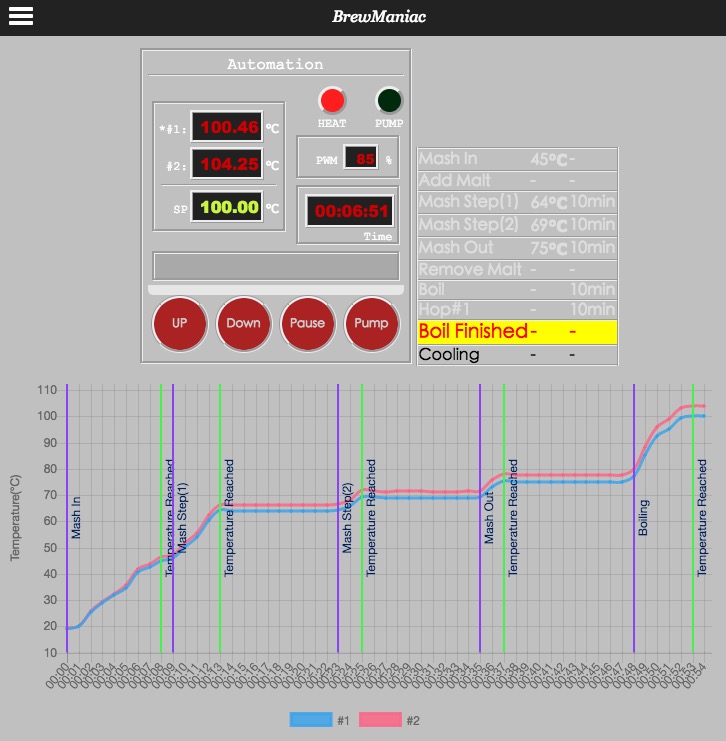Not long ago I built a BrauSupply Clone system. I am going to convert it into an automated system using Open ArbBir and a Arduino Nano.
BrauSupply Clone w/12v pump
https://www.homebrewtalk.com/attachment.php?attachmentid=375665&stc=1&d=1478032600
https://www.homebrewtalk.com/attachment.php?attachmentid=375666&stc=1&d=1478032600
Thus far I have sourced and ordered all the components (I think).
10k Ohm Resistors
1k Ohm Resistors
470 Ohm Resistors
IN4007 Diodes
BC337 Transistors
IRFZ44 Rectifiers
3362P-1-103LF 10k Potentiometer
B008MU206C 12v Relay
DS18B20 Probe and Sensor
2 Pin Plug-in Screw Terminal Block
3 Pin Plug-in Screw Terminal Block
40Pin 2.54mm Single Row Straight Male Pin Header Strip
Copper Clad PCB
PCB Mount Mini Speaker - 8 Ohm 0.2W
20X4 Character LCD Module Display For Arduino
Arduino Nano V3.0 ATmega328
Assorted 3mm/5mm LEDS
Momentary Push Button Switches
Circuit Board Thermal Transfer Paper
Ferric Chloride
My sources have been:
https://www.homebrewtalk.com/showthread.php?t=540002&page=1
https://github.com/ArdBir
https://github.com/arzaman
I have worked on the PCB design as I couldn't figure out how to use the design in the Github to work with the toner transfer method. The main source for toner transfer methods was using the Arduino Uno. After extensive searching found this page http://www.piwo.org/topic/10829-sterownik-do-kadzi-zaciernej/page-4
It had this PCB design I could work with.
https://www.homebrewtalk.com/attachment.php?attachmentid=375672&stc=1&d=1478034120
After a few hours of PhotoShop, scanning, and a Sharpie Pen I ended up with a final PCB design.
https://www.homebrewtalk.com/attachment.php?attachmentid=375673&stc=1&d=1478034201
Getting the correct sizing on the print out for the PCB is my next hurdle.
Now I wait on components to trickle in.
Update:
Found a list of components for the build.
01 Arduino Nano
01 LCD 20x4 Blue background and White letters
01 mini size relay for 12V (not needed if used a SSR for pump)
01 Buzzer 12V
R8 - 120 Ohms
R2, R10, R11, R14, R15 - 1K Ohms
R1 - 2k7 Ohms
R4, R5, R6, R7 - 10k Omhs
R3, R9, R12, R13, R16 - 1M Ohms
P1 - 10k Ohms
D1, D2, D3 - 1N4007
Q1, Q2 - BC337
Q3, Q4 - IRFZ44N
08 Two Way PCB Mount Screw Terminals
02 Three Way PCB Mount Screw Terminals
01 Strip Line Connector Single Row Straight Terminals(come with 40 pins)
01 PCB sigle 11cm X 9cm
4 push-buttons as keypad




BrauSupply Clone w/12v pump
https://www.homebrewtalk.com/attachment.php?attachmentid=375665&stc=1&d=1478032600
https://www.homebrewtalk.com/attachment.php?attachmentid=375666&stc=1&d=1478032600
Thus far I have sourced and ordered all the components (I think).
10k Ohm Resistors
1k Ohm Resistors
470 Ohm Resistors
IN4007 Diodes
BC337 Transistors
IRFZ44 Rectifiers
3362P-1-103LF 10k Potentiometer
B008MU206C 12v Relay
DS18B20 Probe and Sensor
2 Pin Plug-in Screw Terminal Block
3 Pin Plug-in Screw Terminal Block
40Pin 2.54mm Single Row Straight Male Pin Header Strip
Copper Clad PCB
PCB Mount Mini Speaker - 8 Ohm 0.2W
20X4 Character LCD Module Display For Arduino
Arduino Nano V3.0 ATmega328
Assorted 3mm/5mm LEDS
Momentary Push Button Switches
Circuit Board Thermal Transfer Paper
Ferric Chloride
My sources have been:
https://www.homebrewtalk.com/showthread.php?t=540002&page=1
https://github.com/ArdBir
https://github.com/arzaman
I have worked on the PCB design as I couldn't figure out how to use the design in the Github to work with the toner transfer method. The main source for toner transfer methods was using the Arduino Uno. After extensive searching found this page http://www.piwo.org/topic/10829-sterownik-do-kadzi-zaciernej/page-4
It had this PCB design I could work with.
https://www.homebrewtalk.com/attachment.php?attachmentid=375672&stc=1&d=1478034120
After a few hours of PhotoShop, scanning, and a Sharpie Pen I ended up with a final PCB design.
https://www.homebrewtalk.com/attachment.php?attachmentid=375673&stc=1&d=1478034201
Getting the correct sizing on the print out for the PCB is my next hurdle.
Now I wait on components to trickle in.
Update:
Found a list of components for the build.
01 Arduino Nano
01 LCD 20x4 Blue background and White letters
01 mini size relay for 12V (not needed if used a SSR for pump)
01 Buzzer 12V
R8 - 120 Ohms
R2, R10, R11, R14, R15 - 1K Ohms
R1 - 2k7 Ohms
R4, R5, R6, R7 - 10k Omhs
R3, R9, R12, R13, R16 - 1M Ohms
P1 - 10k Ohms
D1, D2, D3 - 1N4007
Q1, Q2 - BC337
Q3, Q4 - IRFZ44N
08 Two Way PCB Mount Screw Terminals
02 Three Way PCB Mount Screw Terminals
01 Strip Line Connector Single Row Straight Terminals(come with 40 pins)
01 PCB sigle 11cm X 9cm
4 push-buttons as keypad










